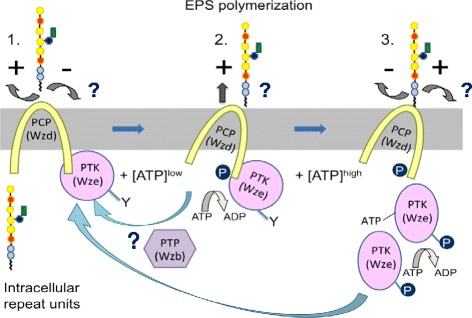Figure 7.

Model proposed for the tyrosine switch controlling EPS polymerization and attachment. 1. Non-phosphorylated Wzd and Wze interact by forming a complex leading to release of EPS (+) rather than attachment (−). 2. In the presence of ATP, Wze phosphorylates Wzd, allowing chain elongation by the polymerase (+). This phosphorylation of Wzd destabilizes the protein interaction with Wze, allowing Wze to either bind with other non-phosphorylated Wzd proteins, or undergo auto- or trans-transphosphorylation. 3. A transitory interaction between phosphor-rylated Wzd and Wze in the presence of ATP is necessary for the phosphorylation of Wze, possibly allowing the attachment of polysaccharide to the cell wall (+). Phosphatase activity of Wzb for dephosphorylating Wzd and Wze would return the cycle to the non-phosphorylated Wzd/Wze complex that allows release of polysaccharide polymers (+). Question marks indicate proposed steps.
